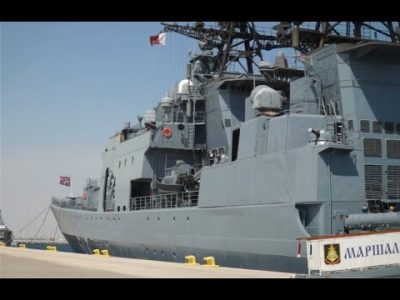Last Updated on 03/04/2020 by OTC
2nd F125 class the frigate named “NORDRHEIN-WESTFALEN” was handed over by the “ARGE F125” consortium to the Federal Office of Bundeswehr on 3 March 2020, Thyssenkrupp has announced via official website. Following the delivery, the “complete prerequisites for the operability of the ship” will be provided by the German Navy and the future crew will receive further training on board.
The NORDRHEIN-WESTFALEN (Pennant Number : F-223) is the second out of four class F125 frigates being built for the German Navy under the leadership of Thyssenkrupp Marine Systems. The lead ship of the frigate class F125, FGS BADEN-WÜRTTEMBERG (Pennant Number : F-125), was handed over at the end of April 2019 and put into service in June 2019. The third unit is planned for delivery this year and the fourth one in 2021.
Rolf Wirtz, CEO of Thyssenkrupp Marine Systems: “The F125 is the most modern frigate in Germany and one of the most modern frigates in the world. Here we are implementing the concept of intensive use for the first time. This is unique worldwide. We are proud to make a significant contribution to the operational capability of our Navy and the defence of our
country with these ships.”
The acceptance ceremony took place at the naval base in Wilhelmshaven. The ship had arrived there the day before from the shipyard in Hamburg. Onboard the NORDRHEIN-WESTFALEN, representatives of the F125 consortium and the Federal Office signed the acceptance documents. The Federal Office in Koblenz was represented by project manager Marc Steffens and the Head of the Acceptance Commission, Wolfgang Lotz, while ARGE project manager Christian Rogge from Thyssenkrupp Marine Systems represented the industry. Delegates from the German Navy also took part in the acceptance ceremony.
By implementing the intensive use concept, class F125 ships can remain in the operational area for up to two years. This can considerably reduce the number of otherwise very long transit journeys. The completely redesigned vessels have highly complex systems and around 28,000 sensors that enable a very high degree of automation. This made it possible to reduce the required number of crew members by about half compared to previous frigate classes. Around 90 percent of the systems onboard the frigates were newly developed specifically for this type of ship.
Besides the traditional tasks of national and alliance defence, the ships are designed especially for conflict prevention and crisis management as well as for intervention and stabilization operations in an international context. In addition to the ability to engage targets on both land and water, they also have air defence systems and helicopters specially equipped for submarine hunting.
ARGE F125 comprises ThyssenKrupp Marine Systems as the lead company and the Bremen-based Fr. Lürssen shipyard. The pre-fitted bow sections were produced at the shipyards of the Lürssen Group in Bremen and in Wolgast on the Baltic Sea. Construction of the stern sections, the joining of the two vessel halves, further fitting-out, commissioning and testing all took place at the Blohm+Voss shipyard in Hamburg under the direction of Thyssenkrupp Marine Systems.

F125 frigate programme :
The German Navy started to plan a successor for the F122 Bremen Class frigates in 1997. It operates eight Bremen Class F122 frigates, which entered service between 1982 and 1990.
The concept of the replacement frigates was original as a multi-role combatant, but by 2005, the requirement for the F125 was based on a capability to counter asymmetric threats and perform stabilisation operations with lethal and non-lethal intervention.
The Baden-Württemberg class have the highest displacement of any class of frigate worldwide. They are to replace the Bremen class. They are primarily designed for low and medium intensity maritime stabilization operations, where they are supposed to provide sea-to-land tactical fire support, asymmetric threat control at sea and support of special forces.
It should be possible to deploy Baden-Württemberg-class frigates for up to two years away from homeports with an average sea operation time of more than 5,000 hours per year (that’s nearly 60%) which includes operation under tropical conditions. For this reason, a combined diesel-electric and gas arrangement has been chosen for the machinery.
General Specifications :
- Length: 149 m
- Beam: 18 m
- Maximum speed: > 26 kts
- Displacement: approx. 7,200 t
- Complement: max. 190 persons (of which 126 are regular crew)
- Propulsion : CODLAG (1 × 20 MW gas turbine, 2 × 4.7 MW electric motors, 4 × 2.9 MW diesel generators, 2 shafts)
- Main sensors : Cassidian TRS-4D AESA radar, Laser warning system, KORA-18 Combined RADAR and COMMS ESM
- Guns: 1 × 127 mm lightweight Otobreda naval gun with guided VULCANO ammunition, 2 × 27 mm MLG 27 remote-controlled autocannons, 12.7 mm guns (remote and manual)
- Missiles : 2 × RAM Block II surface-to-air missile launcher/CIWS (21 cells each), 8 × RGM-84 Harpoon anti-ship missiles (interim solution until joint sea/land attack missile RBS 15 MK4 becomes available)
- Capable to carry 2 × NH-90 helicopters













Comments